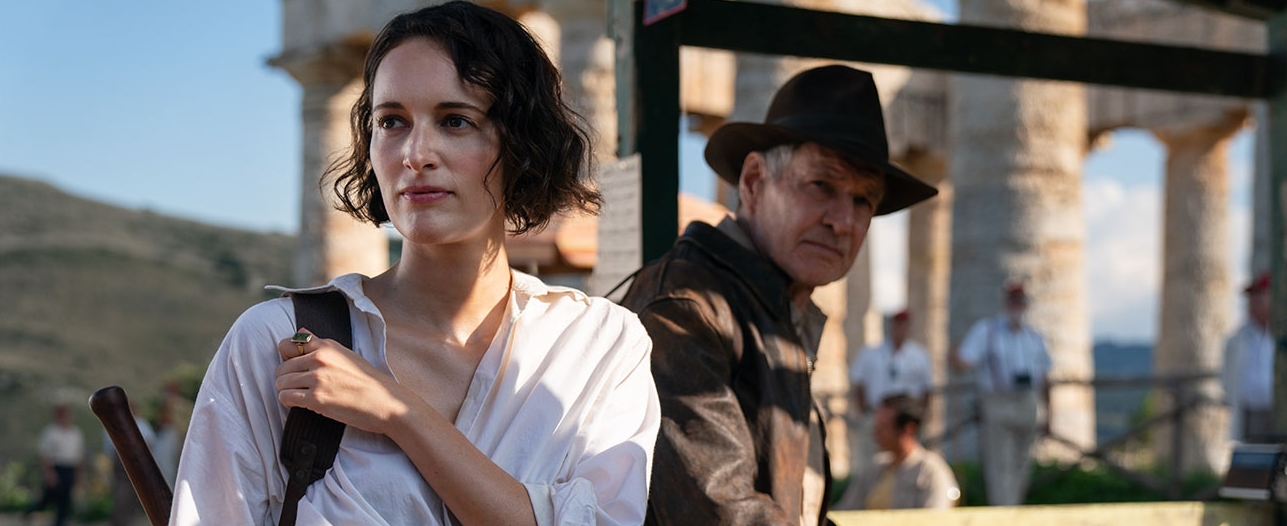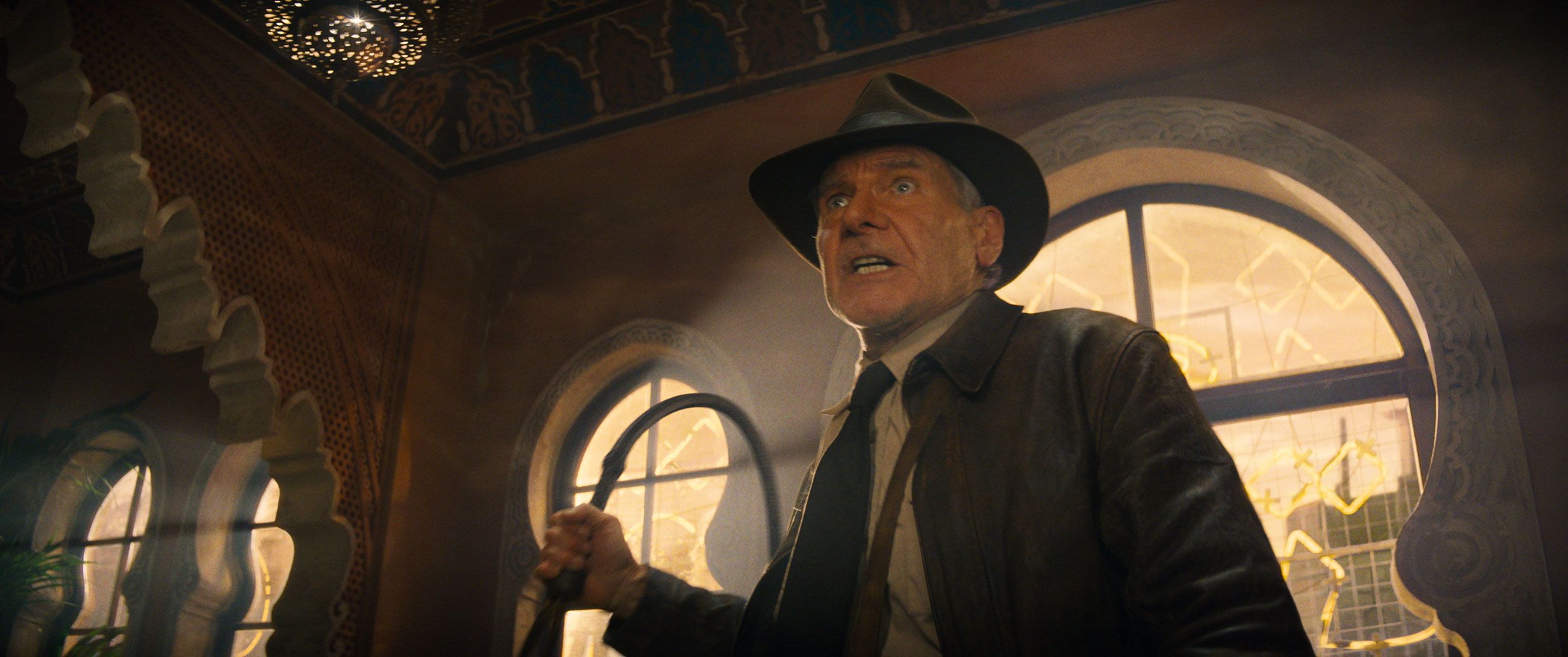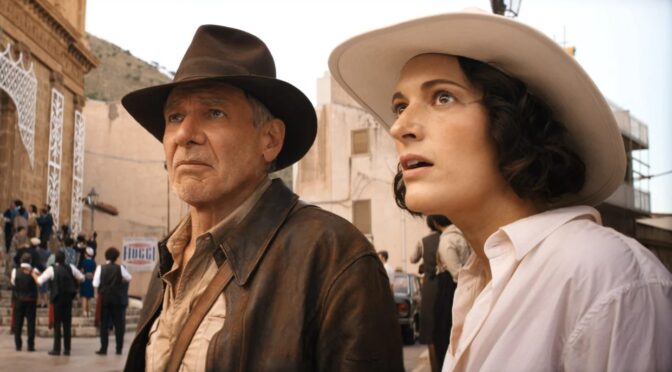The public opinion surrounding the quality of the Indiana Jones saga has always oscillated between undying love and sacrilegious tripe. Outside of RAIDERS OF THE LOST ARK – revered universally – there’s a range of diverse opinions on the others, with 2008’s KINGDOM OF THE CRYSTAL SKULL taking the most flack.
After the overwhelmingly negative response to Crystal Skull, Spielberg has handed over the directorial reins to James Mangold for 2023’s INDIANA JONES AND THE DIAL OF DESTINY. Fresh off the back of the critically acclaimed FORD V FERRARI and beloved superhero flick Logan, Mangold seemed a great choice. While mileage has varied over the years with new directors taking control of projects, there are instances where this has worked. The MISSION: IMPOSSIBLE franchise has stayed fresh and interesting throughout Ethan Hunt’s 24-year career, with different directors imprinting their style and formats onto the franchise.
But there’s always a risk of franchises becoming stale. If McQuarrie continues directing the next bunch of entries, we could also find this happening with M.I., and the Marvel Cinematic Universe is currently floundering in public and critical perception. In part through Disney’s myopic view of what cookie-cutter films they believe audiences want, while their most beloved and best films are the responsibility of auteurs Coogler and Gunn, rather than just the ‘yes men’ of Reed and Watts.
One would hope that Mangold would take over and mark the film as his own, taking inspiration from the previous four films but still branding the entry with his vision. Alas, Spielberg’s shadow is long, and his boots are impossibly big to fill as Mangold’s entry into the Indiana Jones franchise fails to capture what made Spielberg’s adventure flicks so heralded, instead becoming a turgid reminder of how far modern-day blockbuster filmmaking has fallen.
In an extended prologue in 1944, Indiana Jones (Harrison Ford, CGI de-aged like a smooth-faced ventriloquist puppet, still gravelly voiced by the 80-year-old actor) along with new-to-franchise sidekick Basil Shaw (a wasted Toby Jones) attempt to reclaim the spear of Christ from a high-speed train. After realising that the spear they have is a fake, they stumble haphazardly into a lion’s den of Nazi treasure, overseen by Jürgen Voller (Mads Mikkelsen). Voller is preoccupied with keeping hold of the Antikythera, known colloquially throughout as Archimedes’ Dial. Knocking out Voller with a very satisfying punch, the two professors take the dial portion from Voller and jump off the high-speed (green-screened) train into the dark, murky, unintelligible CG water below.

“One would hope that Mangold would take over and mark the film as his own, taking inspiration from the previous four films but still branding the entry with his vision. Alas, Spielberg’s shadow is long, and his boots are impossibly big to fill …”
Flashing forward 25 years to 1969, astronauts are the in thing during the free love protest-filled 1960s while whip-cracking archaeologists are out, the doting fanatics that Jones once had faded away. Those still interested in archaeological discoveries infect his lectures with ambivalent boredom, not dissimilar to the unenthusiastic Indiana. After some classic Indy foreshadowing, he jumps into another adventure, chasing goddaughter Helena Shaw (Phoebe Waller-Bridge) as they are pursued by Voller, whose slightly greyer disposition is the only clue as to the 25 years that have passed. Voller’s alias as a NASA scientist named Johan Schmidt is one of the neater ideas in the film, as real-world Nazi scientists did infiltrate the ranks of US intelligence post-war. With the assistance of CIA Agent Mason (Shaunette Reneé Wilson) and Nazi assassin Klaber (Boyd Holbrook), Voller, still after the Antikythera, frames Dr Jones for multiple murders. With help from Sallah (a returning John Rhys-Davies, still clad in the same fez so audiences can recognise him), Indy flees – rather than plead his very obvious innocence – to retrieve the dial.
The dial has the convoluted and under-explained ability to locate ‘fissures in time’ that transport one back to a particular time and location. There is a brief shot of a date written out by Basil Shaw that is coincidentally two days from that moment, which begs more questions than the script has answers for even if Voller’s villainous idea is actually a fun circumvention of the go-back-and-kill-Hitler time travel trope. He wants to go to 1939 and somehow take Hitler’s place; how a plan to take over the role of a political leader – one that is years in the making – would ever come to fruition is beyond the ideas in the script (a modern comparison seems like trying to replace Donald Trump two weeks before the January 6th Insurrection).
It’s Indiana Jones ‘mission’ that shows that the writers and Mangold have missed the fundamental point about what makes the franchise work: it’s not the idea that Indiana Jones merely goes off on wild adventures searching for artefacts. This notion is not a complete fallacy, as his side quests in the films are shown as such. Still, within the main plot lines of each film, Indiana Jones’ motivations have always been rooted in personal stakes, succinctly cited by Jones in THE LAST CRUSADE “I didn’t come for the cup of Christ. I came to find my father”.
It’s those tight-knit personal stakes – Save my father! Save my girlfriend! – that propel the films and win over the hearts of audiences. Of course, Spielberg’s panache and skilful infusion of charm help, but on a base level, Indy is always motivated by those familial ties. The familial tie in DIAL OF DESTINY is through Helena, Indiana’s goddaughter. Her father’s obsession with the Antikythera caused him to neglect Helena, so the artefact is naturally her obsession – although her idea of archaeology is selling the items she procures to the highest bidder. But in what might be an effort to avoid a damsel in distress trope, Helena is hardly ever in danger. Instead, Indy and Helena are on a mission with newcomer Teddy (Ethann Isidore) to find the other half of a dial that they think doesn’t actually work. The motivation for the plot is that of a historically grand save-the-world-from-Nazis plot, of what has become the misconstrued idea of what the Indiana Jones movies are about.
The iconography of Indiana Jones is in his adventure get-up running through booby traps, switching gold statues with bags of sand and running away from huge boulders while punching Nazis. For those interested in this globe-trotting, fragmented idea of Indiana Jones going after ancient artefacts, DIAL OF DESTINY might work as a form of pastiche, but in which case, media that takes inspiration from Indiana Jones, such as The Librarian series or NATIONAL TREASURE would surely be a better investment in time.
But for those who want an Indiana Jones movie, a soulful, enriching adventure that latches onto the fabric of your spirit, this ain’t it. Whatever Disney, Lucasfilm or Mangold did with this, it is Indiana Jones only in the brand name. Douglas Slocombe’s spellbinding cinematography is sorely missed, not just in actual imagery but in visual texture and shot composition. Where there would be a matte painting, practical locations, or techniques such as forced perspective, there is instead the horrifying crutch that modern blockbuster filmmaking employs, in which entire backgrounds are reformatted with CGI. The worst example is that of the parade chase, which was a constructed set in Glasgow. Yet one wouldn’t be shocked if it had been a soundstage with how much post-production work had been done to it with its oversaturated grading and cheap-looking backgrounds.
The script is a cobbled-together hodgepodge of ideas, each a half-baked draft that should have been economised and streamlined. An old pal of Indiana Jones briefly appears and spouts some jargon about having only three minutes while they dive for the MacGuffin or else they’ll get the ‘bends’, yet nothing comes of it. It’s false tension and screams of old script drafts that have too many ideas bleeding through as it prefers each scene to end with a brisk shift into the next action beat. Helena’s involvement doesn’t work in the grand scheme, but a rather egregious element of the script is its insistence on promoting both her and Teddy to main characters. Teddy, a wannabe pilot who has the plot involvement of a video-game NPC is this film’s version of Ke Huy Quan’s Shortround character. There are also other victims of the wasteful script, namely the subplot of CIA involvement and Boyd Holbrook’s Nazi assassin, who has the on-screen gravitas of white bread. Even John Williams’ score has minimal effect outside of the recognised motifs.

“Douglas Slocombe’s spellbinding cinematography is sorely missed, not just in actual imagery but in visual texture and shot composition. Where there would be a matte painting, practical locations, or techniques such as forced perspective, there is instead the horrifying crutch that modern blockbuster filmmaking employs, in which entire backgrounds are reformatted with CGI.”
An underwater scene is necessary for the plot (the classic find-that-to-find-this-to-find-that). Still, it’s another indistinguishable set piece that has no energy, no charm and not enough narrative purpose behind its prolonged action. To the film’s credit, a Moroccan chase sequence is the strongest, if only because it feels relatively tangible and shot on location. It’s the only time that the fun goofiness you want from an Indiana Jones movie comes across.
The script has no idea what it’s actually doing with its time travel concept. The way the scene concludes is haphazard and almost disrespectful to the character as it removes autonomy of Indiana in favour of wrapping things up. But the concept of Indiana’s reluctance to return from the past is brilliant and harkens back perfectly to Indiana Jones’ dismissal of modern day history. Whatever rewrites occurred at the behest of the various companies infiltrating the creative process, the fragments of that arc seem to still exist underneath the superfluous set pieces, extraordinarily misguided pandering to fans of the franchise, and an erroneous, saccharine final scene with Marion that leaves no one looking good. The scene plays out their reconciliation (from a supposedly fresh divorce) so idealistically that it becomes the most unbelievable moment in a film that features time travel. The lack of emotional weight to the film makes it feel manipulative; done in the hope it will disguise how shaggy the script is and how unpleasant the film is to look at.
An Indiana Jones film should be the gold standard of action-adventure, having been the template for innumerable films over the last 40 years. DIAL OF DESTINY is instead a muddled Frankenstein’s monster; one pieced together haphazardly from elements previously encountered in the franchise.
Perhaps a sense of justified nostalgia for Spielberg’s directorial vision has contributed to the recent affectionate resurgence of KINGDOM OF THE CRYSTAL SKULL. His flair for fluid one-ers and brilliant, subtle blocking has become sorely missed within modern-day filmmaking, making that ‘lesser’ entry in his filmography something to be lauded in comparison. History is being kind to the fun, silly, whimsical chaos that is KINGDOM OF THE CRYSTAL SKULL. For something like the ugly, prosaic and dull DIAL OF DESTINY, which panders to an audience willing to be spoon-fed lines that they once recognised and moves as gracefully as its geriatric lead, lightning won’t strike twice.

